Camp for Climate Action
The Camps for Climate Action are campaign gatherings (similar to peace camps) that take place to draw attention to, and act as a base for direct action against, major carbon emitters, as well as to develop ways to create a zero-carbon society. Camps are run on broadly anarchist principles - free to attend, supported by donations and with input from everyone in the community for the day-to-day operation of the camp. Initiated in the UK, camps have taken place in England at Drax power station, Heathrow Airport, Kingsnorth power station in Kent, the City of London and The Royal Bank of Scotland Headquarters, near Edinburgh. During 2009 camps also took place in Canada, Denmark, France, Ireland, Netherlands/Belgium, Scotland, Wales and Australia.
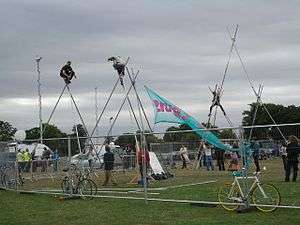
The Camp for Climate Action, first came into being in 2006, after activists at the 2005 G8 conference in Stirling in Scotland mooted the idea.[1]
General
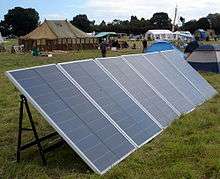
Camps are organised through the preceding year with a series of monthly meetings, previously held in Manchester, Nottingham, Oxford, Leeds, Bristol, London, and Talamh (near Glasgow).
Much of the material used to create structures for the camp is reclaimed waste from building sites which would otherwise have been sent to a landfill. Compost toilets, comprehensive recycling, grey water systems and a pedal-powered laundries.[2] The site of the camp is divided into loosely bounded 'neighbourhoods', most corresponding to geographic region (one exception being the queer neighbourhood of the 2006 camp). Daily consensus-based meetings are held in each neighbourhood, with spokespeople sent to a central meeting.
Power for lighting, radios, mobile phones, sound equipment and laptop computers was supplied by solar panels and a wind turbine. Biodiesel from recycled cooking oil was available for vehicles. Cooking used conventional propane cylinders.[3] In 2007 a satellite up-link was installed, together with a media tent with ten laptop computers,[4] this was also used to send media to the press as well as Indymedia UK.[5]
There is a strong emphasis on the use of bicycles and public transport, including a Bicycology tour from London via Lancaster.[6]
As the United Nations has reported that "livestock is a major threat to environment"[7][8] all food is vegan, mostly organic and locally sourced to minimise food miles, provided by communal neighbourhood kitchens, many associated with the Social Centres Network.
List of Camps for Climate Action
Climate camps started in the UK but have now taken place in a number of countries
| Action | Location | Date |
|---|---|---|
| Drax power station | North Yorkshire, England | August 2006 |
| Heathrow Airport | London, England | August 2007 |
| Kooragang#Kooragang Island | Newcastle, New South Wales, Australia | July 2008[9] |
| Kingsnorth Power station | near London, England | August 2008 |
| Climate camp in the city | London, England | April 2009 |
| Coal Caravan | Northern England | May 2009[10] |
| Mainshill wood | Scotland | August 2009[11] |
| Ffos-y-Fran mine | Wales | August 2009[12] |
| Antwerp Bulk Terminal (ABT) coal terminal | Antwerp, Belgium | August 2009[13] |
| Aéroport du Grand Ouest | Nantes, France | August 2009[13] |
| West Offaly Power station | Shannonbridge, Ireland | August 2009[14] |
| Blackheath London 2009 | Blackheath, London, England | August 2009[15] |
| One of six 'climate action camps' across Canada | Edmonton, Canada | August 2009[16] |
| Climate Camp Aotearoa (New Zealand) | Wellington, New Zealand | December 2009[17] |
| Raffinerie de Normandie | Le Havre, France | July 2010[13] |
| Royal Bank of Scotland Headquarters | Gogarburn, Edinburgh | August 2010[18] |
A camp happened in October 2009 at Helensburgh near Sydney, which is the site of Australia's oldest coal mine.[19]
Drax 2006
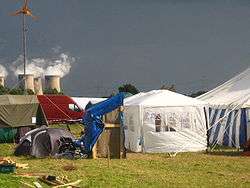
The camp was on a squatted site in the Vale of York, situated close to several large power stations including Drax, a coal-fired power station which is the largest single emitter of carbon dioxide in the UK.[20]
Day of action
On 31 August 2006, up to 600 people attended a protest called Reclaim Power converging on Drax and attempted to shut it down. There was a 'kids march' to Drax Power Station, with a giant ostrich puppet, made by The Mischief Makers. Two protesters climbed a lighting pylon at the edge of the Drax site and four others broke through the fence.[21] Thirty-eight protesters were arrested. The police reported that work at the power plant was not disrupted.[22]
Other protests arising from the camp included a protest against a nuclear power station in Hartlepool, Teesside.[23]
Media response
The Guardian reported that the Camp marked a turning point in grass-roots campaigning against the causes of climate change.[24]
Policing
It would later be revealed that police undercover office Mark Kennedy (police officer) had been involved in the planning for the protests and had been arrested twice during the camp, once at Hartlepool Nuclear Power Station where he locked onto a gate with a bicycle lock around his neck, and a second time close to Draw power station on the day of action, where he was beaten by fellow police officers and arrested for assault.
Heathrow 2007
The 2007 camp (51°29′20″N 0°26′43″W) ran from 14 to 21 August 2007 near London Heathrow Airport next to the village of Sipson on a disused sports ground owned by Imperial College London.[25] Sipson would disappear from the map if the third runway at Heathrow was built.[26]
During the camp there were also protests by Plane Stupid, who were injuncted from protesting at Heathrow. On 13 August Plane Stupid activists boarded a barge transporting an Airbus A380 wing[27] and on 16 August at London Biggin Hill Airport.
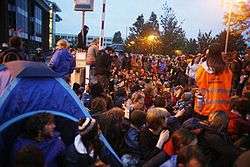
On 19 August, the final day of the camp some 1000-1400 people took part in a 'Day of Action' and 200 people blockaded British Airports Authority HQ.[28]
Injunction
BAA's proposed an injunction against the camp.
The ruling was sought under the auspices of the Protection from Harassment Act 1997. In the end BAA won a more limited injunction[29] and the camp went ahead.
Policing
Policing for the camp was estimated to have cost £7 million by Scotland Yard.[30] The Evening Standard put the costs at £70 million.[31]
In 2007 the police made preventive searches under Section 60 of the Criminal Justice and Public Order Act 1994. The Police carried out some searches, including some vehicles, under Section 44 of the Terrorism Act 2006, and took photos of protesters entering and leaving the camp.[32] On Sunday 19 August there were scuffles between protesters and police officers outside the offices of BAA at Heathrow, which were being targeted in a day of direct action by some of the protesters.[33]
Journalistic access
In relation to the 2007 the National Union of Journalists issued a public statement expressing "deep concern" over a proposed draft policy toward media access during its 2007 event.[34] The camp media team replied to the NUJ criticism by stating: "The policy is a compromise that attempts to provide reasonable media access whilst respecting participants' right to privacy".[35] On 9 August 2007 the proposed policy was amended to remove any possibility of blacklisting some journalists or giving sympathetic journalists longer access.[36]
Kingsnorth 2008
The 2008 camp (51°26′23″N -0°32′54″E) took place in Kent, near E.ON UK's Kingsnorth power station, and run from 4 to 11 August to highlight E.ON's plans to build another coal-fired power station, which would be the first to be built in thirty years in the UK.
The action was also to highlight what is seen as an expansion to the fossil fuel economy, by corporations and government, and what activists claim is a demand for the opposite by scientific consensus. Furthermore, the camp attempted to challenge the businesses which will profit from the agrofuel industry, which they see as false solutions to the problems of climate change.[37][38]

The camp began with a one-day event at Heathrow, the site of the previous year's camp followed by a march across London to Kingsnorth power station, in common with seven other camps globally that were targeting coal.[37]
Over 200 workshops and debates were held during the camp, including ones with George Monbiot, Caroline Lucas, Arthur Scargill and John McDonnell MP.[39] Arthur Scargill, former General Secretary of the National Union of Mineworkers and Dave Douglass, attended the camp to represent many in the mining community who disagreed with the protesters' anti-coal position which they saw as a continuation of the state's assault against them stemming back to the UK miners' strike (1984–1985).
On Saturday 9 August the protesters attempted to shut down the power station. The day was organised to highlight the impact on climate change with activists marching to Kingsnorth power station. Violent scenes developed between the police and the protesters.[40]
On 11 August 2008, several protesters from Oxford and Thames Valley Climate Action glued their hands to the doors of BHP Billiton's headquarters in protest of the use of coal as a fuel. BHP Billiton is the world's largest coal producer.[41]
Policing
1,500 officers were involved at an estimated cost of £5.9m,[42] there were over 100 arrests[43] and some 2000 'potentially harmful' items were confiscated[44] At the time ministers at the time claimed that 70 officers had been injured in the course of their duties, though a Freedom of Information request later showed these included sunburn and wasp stings, and none were caused by protesters.[42]
At the time local MP Bob Marshall-Andrews said that some policing was "provocative and heavy-handed"[45] and Caroline Lucas MEP condemned police tactics, which included riot police, pepper spray and routine stop and search of everyone entering and leaving the camp.[46] In March 2009 the Independent Police Complaints Commission said there was significant public concern at the policing of the camp which should be addressed. These included issues about misconduct, but also in regard to operational tactics including claims that officers used loud music at night to disrupt protesters who were trying to sleep.[47]
Before the camp started police had found weapons hidden in nearby woods which included knives, a replica throwing star and a large chain and padlock. Assistant Chief Constable Gary Beautridge stated that while he believed the majority of the Climate Camp protesters to be peaceful, he was concerned that some had "more sinister intentions".[48]
In June, 2009, the Guardian released video evidence of alleged brutality by police officers at the camp against two women. They belonged to the campaign group, Fitwatch, who campaign against the use of forward intelligence teams. They spotted several officers who did not have visible epaulettes and when they asked the officers to reveal their identities they were arrested.[49][50]
Camp in the City 2009
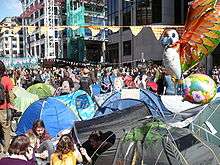
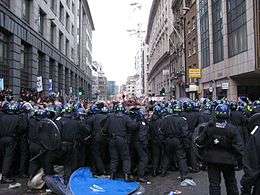
The Camp in the City (51.5152°N 0.0825°W) took place on 1 April 2009 was one of a number of protests associated with the G20 London Summit. The aim was to draw attention to carbon trading.[51] The camp took place outside the European Climate Exchange in Bishopsgate and was distinct from the G-20 Meltdown protest that took place outside the Bank of England.[52]
Camp for Climate Action organisers agreed to meet with police and exchange contact details shortly before the protest. The meeting was arranged by Liberal Democrat MP David Howarth, who was to mediate at the meeting which was to take place at the House of Commons. Scotland Yard confirmed that a meeting was to take place with Bob Broadhurst (police commander) and Ian Thomas (chief superintendent).[53]
The camp, which was intended to last for 24 hours, started at 12:30 pm when a camp was established in a section of Bishopsgate between Threadneedle Street and London Wall with tents set up and bunting across the road reading 'Nature doesn't do bailouts'.[54]
At about 7 pm the police stopped allowing people to enter or leave the protest.[55] The police advanced on protesters who put their hands in the air and resisted while chanting "This is not a riot"[56] which is a tactic that emerged over the course of a number of Camp for Climate Action gatherings.[57] There were scuffles with the police. Within the cordon people carried on playing music and preparing food and until the police began letting people leave at about 11:30 pm[55] and cleared the area of the last protesters at about 2 am.[58]
Blackheath 2009

The camp at Blackheath (51°28′17″N 0°0′14″E) was set up on 26 August on Blackheath Common, which was the site of the 1381 Peasants' Revolt and was due to run until 2 September.[15] The organisers kept the location of the camp secret from the police until the first day of the camp.[59] About 1000 people arrived on the first day with the police adopting a low-key 'community policing' approach[60] and using Twitter for the first time to communicate with protesters[61] and senior officers held five meetings with protesters to prepare for the event.[62]
A number of protests at locations around London took place during the camp.[63]
Shops and local pubs reported good business and police presence was keep very low profile and unobtrusive.[64] The Telegraph described it as "the cheapest – and chic-est – date in the summer festival calendar".[65] Climate Camp TV provided a view of the camp and the associated actions.[66]
Ratcliffe-on-Soar 2009
Between 17 and 18 October 2009, protesters from Camp for Climate Action, Climate Rush and Plane Stupid,[67] took part in 'The Great Climate Swoop' at Ratcliffe-on-Soar Power Station. The police arrested 10 people before the protest began on suspicion of conspiracy to cause criminal damage.[68] Some 1,000 people took part, and during the first day groups of up to several hundred people pulled down security fencing at a number of points around the plant.[69] Fifty six arrests were made during the protest and there were a number of injuries to Police and Protestors, including one policeman who was airlifted to hospital.
A spokesman for E.ON, which was granted a High Court injunction giving police the power to arrest anyone who tried to enter the site, said: "There aren't any winners or losers here. It was a less than peaceful protest. "Protesters were hurt, policemen were hurt and the power station carried on producing energy regardless. "I don't think it added anything to the debate on the UK's energy future."[70]
After the event Julian Baggini, writing in The Times, criticised the protest arguing that climate change did not constitute a justifiable reason for civil disobedience.[71] In response activists said that the urgency of responding to potential extreme climate change did indeed provide sufficient justification.[72]
Edinburgh 2010
The camp was set up on 18 August in the grounds of The Royal Bank of Scotland Headquarters, Gogarburn, near Edinburgh, to protest against the banks involvement in financing environmentally damaging activities, particularly Canadian Tar Sands and ran until 25 August.[73] The organisers took the site the day before the publicly announced date, in order to avoid the police. Actions took place across the week against RBS, and other companies involved in environmentally damaging industries, as well as various workshops on a range of environmental, social and climate change issues:[74][75]
A number of protests at locations around Edinburgh took place during the camp.[76]
Climate Camp TV provided a view of the camp and the associated actions.[66]
See also
- Environmental direct action in the United Kingdom
- Earth First!
- Plane Stupid
- The Mischief Makers
- Renewable energy commercialization
- Solar energy
- List of environmental protests
- List of large wind farms
- List of notable renewable energy organizations
- List of renewable energy topics by country
- Ende Gelände 2015
- Ende Gelände 2016
References
- Zee, Bibi van der (2 March 2011). "Climate Camp disbanded". the Guardian. Retrieved 23 November 2018.
One activist remembers: "We built a camp up in Scotland, and had about 4,000-5,000 people there, and after we pulled that off, we realised that actually, now we had the infrastructure to try something like this. We had marquees, mobile kitchens, and the ability to organise, and this really seemed to be the moment."
- "Handout for climate camp workshops" (PDF).
- Pidd, Helen (15 August 2007). "Rules, rotas and revolutionary song at climate action camp". The Guardian. London. Retrieved 26 March 2010.
- Helen Pidd. "A new weather front". The Guardian. Camp for climate action. Archived from the original on 21 December 2007. Retrieved 21 June 2019.
- Camp for Climate Action 2007 Newswire, Indymedia UK.
- "2006 Bicycology sTOURy|accessed 2010-01-10".
- "Livestock a major threat to environment". United Nations Food and Agriculture Organization. 20 November 2006.
- Steph Brown. "Fight climate change! Go vegan!". Archived from the original on 20 December 2007. Retrieved 21 June 2019.
- Australia's Newcastle Coal Price Falls From Record (Update) Jesse Riseborough 14 July 2008 Bloomberg
- "COAL CARAVAN - route & dates update". Archived from the original on 24 December 2008. Retrieved 26 August 2009.
- "Climate Camp Scotland".
- "climatecamp.org.uk/blog/2009/08/22/climate-camp-cymru-ffos-y-fran-mine-action". Archived from the original on 28 August 2009. Retrieved 26 August 2009.
- "News from climate action camps in Scotland, Belgium/Netherlands and France". Archived from the original on 10 September 2017. Retrieved 26 August 2009.
- "Activists to continue protest at ESB power plant". The Irish Times. 8 August 2009.
- Batty, David (26 August 2009). "Climate Camp hits London". The Guardian. Retrieved 26 August 2009.
- "Greenpeace camp for 'climate defenders'". Edmonton Sun. Retrieved 29 August 2009.
- "Archived copy". Archived from the original on 16 July 2011. Retrieved 6 March 2010.CS1 maint: archived copy as title (link)
- Severin, Carrell (19 August 2010). "Activists set up Climate Camp at Royal Bank of Scotland Headquarters". The Guardian.
- "Climate Camp 09: Oct 9 – 11. Australia's oldest coal mine, Helensburgh, 40 minutes south of Sydney". Archived from the original on 20 August 2009. Retrieved 29 August 2009.
- "Power station protesters arrested". BBC News. 1 September 2006. Retrieved 2 January 2010.
- Wainwright, Martin (1 September 2006). "In the shadow of Drax, not so much a fight as a festival". The Guardian. London. Retrieved 26 March 2010.
- Brown, Jonathan (1 September 2006). "The Battle of Drax: 38 held as protest fails to close plant". The Independent. London. Archived from the original on 1 March 2007. Retrieved 2010-04-28.
- Ward, David (30 August 2006). "Energy protesters blockade nuclear power station". The Guardian. London. Retrieved 28 April 2010.
- Green goes mainstream. The Guardian - 1 September 2006
- "Climate Camp at Heathrow".
- Ryan, Margaret (21 February 2006). "Village faces being wiped off map". BBC News Online. Retrieved 4 March 2008.
- "Plane Stupid occupy Airbus A380 wing - BBC News". Archived from the original on 8 February 2011. Retrieved 10 April 2009.
- "Campaigners leave Heathrow camp". BBC News. 20 August 2008. Retrieved 5 March 2008. Including map of proposed third runway
- "Heathrow protesters ban". BBC News. 6 August 2007. Retrieved 2 January 2010.
- "Heathrow protest police cost £7m". BBC News. 6 September 2007. Retrieved 5 March 2008.
- "Anarchists to flood in as new Heathrow T5 opens". 19 February 2008. Archived from the original on 28 February 2008. Retrieved 4 March 2008.
- Jon Kelly (13 August 2007). "Eco-village with a stark warning". BBC News.
- "Minor scuffles in airport protest". BBC News. 19 August 2007. Retrieved 2 January 2010.
- "NUJ warns Climate Camp over restrictions on media". National Union of Journalists. 7 August 2007.
- "Climate camp response to NUJ Criticisms". Indymedia.
- "Camp for climate action - Climate camp amended Press Policy, 2007". Archived from the original on 27 September 2007. Retrieved 15 August 2007.
- "Climate Camp Press Release: Camp to target Kingsnorth". Climate Camp. Archived from the original on 10 March 2008. Retrieved 4 March 2008.
- Climate Camp 2008 to target Kingsnorth power station, Indymedia UK 4 March 2008.
- "Arthur Scargill, Caroline Lucas kick off Climate Camp workshops Mon 4 Aug". Archived from the original on 6 September 2010. Retrieved 10 April 2009.
- Police at Climate Camp. blip.tv (Documentary). Kingsnorth, England. Archived from the original on 20 August 2008. Retrieved 3 April 2009.
- "Coal protest team glued to doors"
- Vidal, John (15 December 2008). "Those Kingsnorth police injuries in full: six insect bites and a toothache". The Guardian. London. Retrieved 7 April 2009.
- Miller, Vikki; Leach, Ben (9 August 2008). "Kent power station protest: Over 50 environmental activists arrested". The Telegraph. London. Retrieved 26 March 2010.
- McVeigh, Tracy (1 March 2009). "Police 'over the top' at climate camp". The Observer. London. Retrieved 26 March 2010.
- "Climate camp policing condemned". BBC News. 5 August 2008. Retrieved 2 January 2010.
- Caroline Lucas (4 August 2008). "Dirty tactics to defend a dirty industry". The Guardian. London. Retrieved 26 March 2010.
- "Concern over Climate Camp police". BBC News. 27 March 2009. Retrieved 7 April 2009.
- "'Weapons Stash' near Climate Camp". BBC News. 9 August 2008. Retrieved 7 April 2009.
- Lewis, Paul (23 June 2009). "Surveillance protesters bundled to ground by police". The Guardian. London. Retrieved 23 June 2009.
- "Numbers must be on display". Daily Mail. London. 17 April 2009. Retrieved 3 July 2009.
- "Carbon trading". Climate Camp. Archived from the original on 22 June 2009. Retrieved 2009-04-07.
- "Timetable Of Disruption: The Summit Protests". Sky News. Retrieved 7 April 2009.
- Lewis, Paul (30 March 2009). "Police agree to urgent talks with G20 protesters". The Guardian. London. Retrieved 26 March 2010.
- Casciani, Dominic (1 April 2009). "Eyewitness: Climate Camp in the City". BBC News. Retrieved 7 April 2009.
- McGrath, Beth (2 April 2009). "G20: The police ruined a peaceful protest". Guardian. London. Retrieved 7 April 2009.
- "Police brutality at Camp for Climate Action in the City of London". Plane Stupid. Archived from the original on 9 April 2009. Retrieved 7 April 2009.
- "This is not a riot: an effective, nonviolent response to attacks by riot police". Young Anabaptist Radicals. Retrieved 8 April 2009.
- "Peace, love and riot police". Sky news. Archived from the original on 16 October 2009. Retrieved 7 April 2009.
- Scotland Yard 'disappointed' at failing to discover location of Climate Camp Richard Edwards The Daily Telegraph 25 Aug 2009
- Walker, Peter (27 August 2009). "Police adopt low profile as 1,000 Climate Camp activists set up base". The Guardian. London. Retrieved 29 August 2009.
- "Bobby on the Tweet: British Police Try Twitter". Time. Retrieved 20 August 2009.
- Randerson, James (26 August 2009). "Blackheath revealed as Climate Camp location". The Guardian. London. Retrieved 26 March 2010.
- "Protesters glued to floor of bank". BBC News. 1 September 2009. Retrieved 2 January 2010.
- "BLACKHEATH: Climate Camp leaves as shops count profits".
- West, Ed (29 August 2009). "Climate Camp: Wat Tyler would have felt at home among the 'fluffys' in Blackheath". The Telegraph. London. Retrieved 26 March 2010.
- "Climate Camp TV".
- "Hundreds of protesters expected to 'take over' Ratcliffe-on-Soar power station". The is Nottingham. Archived from the original on 5 May 2013.
- Dwyer, Danielle (17 October 2009). "Ten held ahead of power station protest". The Independent. London. Retrieved 28 April 2010.
- "Climate protest enters second day". BBC News. 18 October 2009. Retrieved 2 January 2010.
- "Power station demonstration ends". BBC News. 18 October 2009. Retrieved 2 January 2010.
- Baggini, Julian (19 October 2009). "Green guerrillas are following a noble tradition". The Times. London. Retrieved 26 March 2010.
- "We're doing it ourselves: why Baggini has got it wrong". OneClimate. 19 October 2009. Archived from the original on 24 November 2009. Retrieved 19 October 2009.
- "Climate protest camp targets RBS headquarters". BBC. 19 August 2010.
- "Workshops Programme". Camp for climate action. Archived from the original on 28 August 2009. Retrieved 29 August 2009.
- Gregory, Amelia (27 August 2010). "Climate Camp 2010 at the RBS HQ in Edinburgh". Amelia's Magazine.
- "Climate activists target RBS". BBC News. 3 September 2010. Retrieved 20 January 2012.
External links
- Camp for Climate Action web-page
- Camp for Climate Action list of local groups
- Announcements list for Camp for Climate Action information
- Network for Climate Action
- Sustainable Community Action wiki's Camp for Climate Action 2007 page
- Ecological direct action reports from the UK & beyond
- HACAN website
- films produced at the visionOntv studio during the Camp for Climate Action
- German climate camps